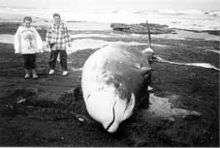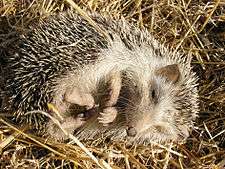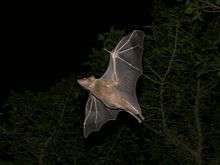List of mammals of the Canary Islands
This is a list of the mammal species recorded in the Canary Islands, Spain.[1] Since the Osorian shrew (Crocidura osorio) was proven to be actually a population of introduced European greater white-toothed shrew (C. russula)[2] the Canarian shrew, C. canariensis is believed to be the only surviving native terrestrial mammal of the archipelago, every other species nowadays present having been voluntarily or accidentally introduced by humans.[3]
The following tags are used to highlight each species' conservation status as assessed by the IUCN.
| EX | Extinct | No reasonable doubt that the last individual has died. |
| EW | Extinct in the wild | Known only to survive in captivity or as a naturalized populations well outside its previous range. |
| CR | Critically Endangered | The species is in imminent risk of extinction in the wild. |
| EN | Endangered | The species is facing an extremely high risk of extinction in the wild. |
| VU | Vulnerable | The species is facing a high risk of extinction in the wild. |
| NT | Near Threatened | The species does not meet any of the criteria that would categorise it as risking extinction but it is likely to do so in the future. |
| LC | Least Concern | There are no current identifiable risks to the species. |
| DD | Data Deficient | There is inadequate information to make an assessment of the risks to this species. |
Some species were assessed using an earlier set of criteria. Species assessed using this system have the following instead of Near Threatened and Least Concern categories:
| LR/cd | Lower Risk/conservation dependent | Species which were the focus of conservation programmes and may have moved into a higher risk category if that programme was discontinued. |
| LR/nt | Lower Risk/near threatened | Species which are close to being classified as Vulnerable but are not the subject of conservation programmes. |
| LR/lc | Lower Risk/least concern | Species for which there are no identifiable risks. |
Subclass: Theria
Infraclass: Eutheria
Order: Rodentia (rodents)

Rodents make up the largest order of mammals, with over 40 percent of mammalian species. They have two incisors in the upper and lower jaw which grow continually and must be keep short by gnawing. Most rodents are small though the capybara can weigh up to 45 kg (100 lb).
- Suborder: Sciuromorpha
- Family: Sciuridae (squirrels)
- Subfamily: Xerinae
- Genus: Atlantoxerus
- Barbary ground squirrel Atlantoxerus getulus LC (introduced)
- Genus: Atlantoxerus
- Subfamily: Xerinae
- Family: Sciuridae (squirrels)
- Suborder: Myomorpha
- Family: Muridae (mice and rats)
- Subfamily: Murinae
- Genus: Canariomys[4]
- Tenerife giant rat Canariomys bravoi EX
- Gran Canaria giant rat Canariomys tamarani EX
- Genus: Malpaisomys
- Lava mouse Malpaisomys insularis EX[5]
- Genus: Mus
- House mouse Mus musculus LC (introduced)
- Genus: Rattus
- Genus: Canariomys[4]
- Subfamily: Murinae
- Family: Muridae (mice and rats)
Order: Lagomorpha (lagomorphs)
The lagomorphs comprise two families, Leporidae (hares and rabbits), and Ochotonidae (pikas). Though they can resemble rodents, and were classified as a superfamily in that order until the early 20th century, they have since been considered a separate order. They differ from rodents in a number of physical characteristics, such as having four incisors in the upper jaw rather than two.
- Family: Leporidae (rabbits, hares)
- Genus: Oryctolagus
- European rabbit Oryctolagus cuniculus LR/lc (introduced)
- Genus: Oryctolagus
Order: Erinaceomorpha (hedgehogs and gymnures)
The order Erinaceomorpha contains a single family, Erinaceidae, which comprise the hedgehogs and gymnures. The hedgehogs are easily recognised by their spines while gymnures look more like large rats.
- Family: Erinaceidae (hedgehogs)
- Subfamily: Erinaceinae
- Genus: Atelerix
- North African hedgehog Atelerix algirus LR/lc (introduced)
- Genus: Atelerix
- Subfamily: Erinaceinae
Order: Soricomorpha (shrews, moles, and solenodons)
The "shrew-forms" are insectivorous mammals. The shrews and solenodons closely resemble mice while the moles are stout bodied burrowers.
- Family: Soricidae (shrews)
- Subfamily: Crocidurinae
- Genus: Crocidura
- Canarian shrew Crocidura canariensis EN
- Greater white-toothed shrew Crocidura russula LC (introduced)
- Genus: Suncus
- Etruscan shrew Suncus etruscus LC (introduced)
- Genus: Crocidura
- Subfamily: Crocidurinae
Order: Chiroptera (bats)
The bats' most distinguishing feature is that their forelimbs are developed as wings, making them the only mammals in the world naturally capable of flight. Bat species account for about 20% of all mammals.
- Suborder: Megachiroptera
- Family: Pteropodidae (flying foxes, Old World fruit bats)
- Genus: Rousettus
- Egyptian fruit bat Rousettus aegyptiacus LC (introduced)
- Genus: Rousettus
- Family: Pteropodidae (flying foxes, Old World fruit bats)
- Suborder: Microchiroptera
- Family: Molossidae (free-tailed bats)
- Subfamily: Molossinae
- Genus: Tadarida
- European free-tailed bat Tadarida teniotis LC
- Genus: Tadarida
- Subfamily: Molossinae
- Family: Vespertilionidae (vesper bats)
- Subfamily: Vespertilioninae
- Genus: Barbastella
- Barbastelle Barbastella barbastellus NT
- Genus: Hypsugo
- Savi's pipistrelle Hypsugo savii LC
- Genus: Nyctalus
- Lesser noctule Nyctalus leisleri LC
- Genus: Pipistrellus
- Kuhl's pipistrelle Pipistrellus kuhlii LC
- Madeira pipistrelle Madeira pipistrelle VU
- Genus: Plecotus
- Canary big-eared bat Plecotus teneriffae EN
- Genus: Barbastella
- Subfamily: Vespertilioninae
- Family: Molossidae (free-tailed bats)
Order: Cetacea (whales)



The order Cetacea includes whales, dolphins and porpoises. They are the mammals most fully adapted to aquatic life with a spindle-shaped nearly hairless body, protected by a thick layer of blubber, and forelimbs and tail modified to provide propulsion underwater.
- Suborder: Mysticeti
- Family: Balaenopteridae (rorquals)
- Genus: Balaenoptera
- Minke whale Balaenoptera acutorostrata LC
- Blue whale Balaenoptera musculus EN
- Bryde's whale Balaenoptera edeni DD
- Fin whale Balaenoptera physalus EN
- Genus: Megaptera
- Humpback whale Megaptera novaeangliae LC
- Genus: Balaenoptera
- Family: Balaenidae
- Genus: Eubalaena
- North Atlantic right whale Eubalaena glacialis EN (once common, now almost extinct)
- Genus: Eubalaena
- Family: Balaenopteridae (rorquals)
- Suborder: Odontoceti
- Family: Delphinidae (dolphins and pilot whales)
- Genus: Delphinus
- Short-beaked common dolphin Delphinus delphis LC
- Genus: Globicephala
- Short-finned pilot whale Globicephala macrorhynchus DD
- Long-finned pilot whale Globicephala melas DD
- Genus: Grampus
- Risso's dolphin Grampus griseus LC
- Genus: Lagenodelphis
- Fraser's dolphin Lagenodelphis hosei LC
- Genus: Orcinus
- Orca Orcinus orca DD
- Genus: Pseudorca
- False killer whale Pseudorca crassidens DD
- Genus: Stenella
- Striped dolphin Stenella coeruleoalba LC
- Atlantic spotted dolphin Stenella frontalis DD
- Genus: Steno
- Rough-toothed dolphin Steno bredanensis DD
- Genus: Tursiops
- Common bottlenose dolphin Tursiops truncatus LC
- Genus: Delphinus
- Family: Kogiidae (small sperm whales)
- Genus: Kogia
- Pygmy sperm whale Kogia breviceps DD
- Dwarf sperm whale Kogia sima DD
- Genus: Kogia
- Family: Physeteridae (sperm whales)
- Genus: Physeter
- Sperm whale Physeter macrocephalus VU
- Genus: Physeter
- Family: Ziphiidae (beaked whales)
- Genus: Hyperoodon
- Northern bottle-nosed whale Hyperoodon ampullatus LC
- Genus: Mesoplodon
- Blainville's beaked whale Mesoplodon densirostris DD
- Gervais' beaked whale Mesoplodon europaeus DD
- True's beaked whale Mesoplodon mirus DD
- Genus: Ziphius
- Cuvier's beaked whale Ziphius cavirostris LC
- Genus: Hyperoodon
- Family: Delphinidae (dolphins and pilot whales)
Order: Carnivora (carnivorans)
.jpg)
There are over 260 species of carnivorans, the majority of which feed primarily on meat. They have a characteristic skull shape and dentition.
- Suborder: Feliformia
- Suborder: Caniformia
- Family: Phocidae (earless seals)
- Genus: Monachus
- Mediterranean monk seal Monachus monachus CR
- Genus: Monachus
- Family: Phocidae (earless seals)
Order: Artiodactyla (even-toed ungulates)
The even-toed ungulates are ungulates whose weight is borne about equally by the third and fourth toes, rather than mostly or entirely by the third as in perissodactyls. There are about 220 artiodactyl species, including many that are of great economic importance to humans.
- Family: Bovidae (cattle, antelope, sheep, goats)
- Subfamily: Caprinae
- Genus: Ammotragus
- Barbary sheep Ammotragus lervia VU (introduced)
- Genus: Capra
- Feral goat Capra hircus LR/lc (introduced)
- Genus: Ovis
- Mouflon Ovis aries orientalis VU (introduced)
- Genus: Ammotragus
- Subfamily: Caprinae
Notes
- ↑ The taxonomy and naming of the individual species is based on those used in existing Wikipedia articles as of 9 January 2013 and supplemented by the common names and taxonomy from the IUCN where no Wikipedia article was available.
- ↑ Molina, O. et al. (2003) "The origin of the Osorian shrew (Crocidura osorio) from Gran Canaria resolved using mtDNA". Italian Journal of Zoology, Volume 70, Issue 2
- ↑ Hutterer, R. et al. (1992) "Origin and evolution of the endemic Canary Island shrews (Mammalia: Soricidae)" Biological Journal of the Linnean Society, Volume 46, Issue 1-2, pages 49–58
- ↑ Musser, G.G.; Carleton, M.D. (2005). "Superfamily Muroidea". In Wilson, D.E.; Reeder, D.M. Mammal Species of the World: A Taxonomic and Geographic Reference (3rd ed.). Johns Hopkins University Press. p. 1357. ISBN 978-0-8018-8221-0. OCLC 62265494.
- ↑ Boye', P.; Hutterer, R.; López-Martínez, N. & Michaux, Jacques (1992): A reconstruction of the Lava mouse (Malpaisomys insularis), an extinct rodent of the Canary Islands. Zeitschrift für Säugetierkunde 57(1): 29–38. HTML abstract
References
- "Atlas y Libro Rojo de los mamíferos terrestres de España". Gobierno de España - Ministerio de Agricultura, Alimentación y Medio Ambiente. 2012. Retrieved 2 Jan 2013.
- Nogales, M. et al. (2006) "Ecological effects and distribution of invasive non-native mammals on the Canary Islands" Mammal Rev. 2006, Volume 36, No. 1, 49–65
- Purroy, F.J. and Varela, J.M. (2003) Guía de los Mamíferos de España. Península, Baleares y Canarias. Lynx Edicions, Barcelona.
See also
- List of chordate orders
- List of regional mammals lists
- List of prehistoric mammals
- Mammal classification
- New mammal species







